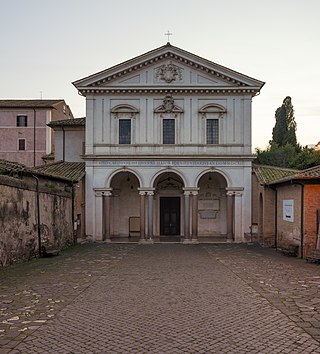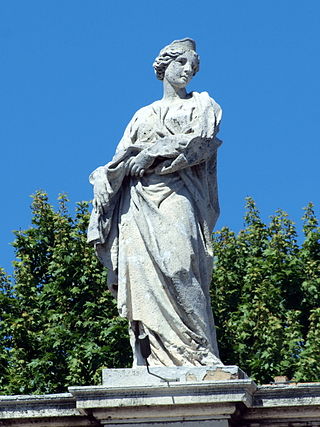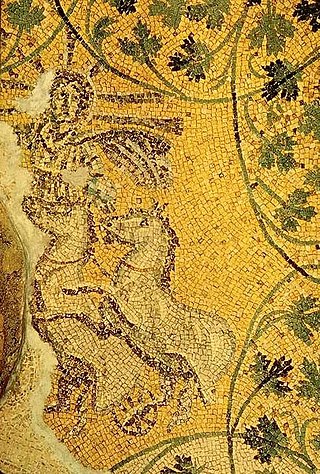
Pope Callixtus I, also called Callistus I, was the bishop of Rome from c. 218 to his death c. 222 or 223. He lived during the reigns of the Roman emperors Elagabalus and Alexander Severus. Eusebius and the Liberian catalogue list his episcopate as having lasted five years (217–222). In 217, when Callixtus followed Zephyrinus as Bishop of Rome, he started to admit into the Church converts from sects or schisms. He was killed for being Christian and is venerated as a saint by the Catholic Church.

The Appian Way is one of the earliest and strategically most important Roman roads of the ancient republic. It connected Rome to Brindisi, in southeast Italy. Its importance is indicated by its common name, recorded by Statius, of Appia longarum... regina viarum . The road is named after Appius Claudius Caecus, the Roman censor who, during the Samnite Wars, began and completed the first section as a military road to the south in 312 BC.

Santa Maria in Palmis, also known as Chiesa del Domine Quo Vadis, is a small church southeast of Rome. It is located about some 800 m from Porta San Sebastiano, where the Via Ardeatina branches off the Appian Way, on the site where, according to the apocryphal Acts of Peter, Saint Peter met the risen Christ while Petrus was fleeing persecution in Rome. According to the tradition, Peter asked him, "Lord, where are you going?". Christ answered, "I am going to Rome to be crucified again".

Catacombs are human-made subterranean passageways for religious practice. Any chamber used as a burial place is considered a catacomb, although the word is most commonly associated with the Roman Empire.

The Catacombs of Rome are ancient catacombs, underground burial places in and around Rome, of which there are at least forty, some rediscovered only in recent decades.

Saint Peter's tomb is a site under St. Peter's Basilica that includes several graves and a structure said by Vatican authorities to have been built to memorialize the location of Saint Peter's grave. St. Peter's tomb is alleged near the west end of a complex of mausoleums, the Vatican Necropolis, that date between about AD 130 and AD 300. The complex was partially torn down and filled with earth to provide a foundation for the building of the first St. Peter's Basilica during the reign of Constantine I in about AD 330. Though many bones have been found at the site of the 2nd-century shrine, as the result of two campaigns of archaeological excavation, Pope Pius XII stated in December 1950 that none could be confirmed to be Saint Peter's with absolute certainty. Following the discovery of bones that had been transferred from a second tomb under the monument, on June 26, 1968, Pope Paul VI said that the relics of Saint Peter had been identified in a manner considered convincing. Only circumstantial evidence was provided to support the claim.

San Sebastiano fuori le mura, or San Sebastiano ad Catacumbas, is a minor basilica in Rome, Central Italy. Up to the Great Jubilee of 2000, San Sebastiano was one of the Seven Pilgrim Churches of Rome, and many pilgrims still favour the traditional list.

The mythical Balbina of Rome, sometimes called Saint Balbina and Balbina the Virgin has been venerated as a virgin martyr and saint of the Catholic Church. As is made clear in the Catholic Encyclopaedia, it seems what follows has been nothing more than fable, not history.

Petronilla is an early Christian saint. She is venerated as a virgin by the Catholic Church. She died in Rome at the end of the 1st century, or possibly in the 3rd century.

The Catacomb of Priscilla is an archaeological site on the Via Salaria in Rome, Italy, situated in what was a quarry in Roman times. This quarry was used for Christian burials from the late 2nd century through the 4th century. This catacomb, according to tradition, is named after the wife of the Consul Manius Acilius Glabrio; he is said to have become a Christian and was killed on the orders of Domitian. Some of the walls and ceilings display fine decorations illustrating Biblical scenes.

Saint Hermes, born in Greece, died in Rome as a martyr in 120, is venerated as a saint by the Catholic Church and the Eastern Orthodox Church. His name appears in the Martyrologium Hieronymianum as well as entries in the Depositio Martyrum (354). There was a large basilica over his tomb that was built around 600 by Pope Pelagius I and restored by Pope Adrian I. A catacomb in the Salarian Way bears his name.

Quirinus is venerated as an early bishop of Sescia, now Sisak in Croatia. He is mentioned by Eusebius of Caesarea.

The Vatican Necropolis lies under the Vatican City, at depths varying between 5–12 metres below Saint Peter's Basilica. The Vatican sponsored archaeological excavations under Saint Peter's in the years 1940–1949 which revealed parts of a necropolis dating to Imperial times. The work was undertaken at the request of Pope Pius XI who wished to be buried as close as possible to Peter the Apostle. It is also home to the Tomb of the Julii, which has been dated to the third or fourth century. The necropolis was not originally one of the Catacombs of Rome, but an open-air cemetery with tombs and mausolea.

The Vigna Randanini are Jewish Catacombs between the second and third miles of the Appian Way close to the Christian catacombs of Saint Sebastian, with which they were originally confused. The catacombs date between the 2nd and 5th-centuries CE, and take their name from the owners of the land when they were first formally discovered and from the fact that the land was used as a vineyard (vigna). While Vigna Randanini are just one of the two Jewish catacombs in Rome open to the public, they can only be visited by appointment. They are situated below a restaurant and a private villa and entrance is from the Via Appia Pignatelli side. These catacombs were discovered by accident in 1859, although there is evidence that they had been pillaged before then. They cover an area of 18,000 square metres and the tunnels are around 700 metres long, of which around 400 can be seen.

The Catacomb of Generosa is a catacomb of Rome (Italy), located in Via delle Catacombe di Generosa, close to a big bight of river Tiber on the right bank, in the Portuense quarter.

The Catacomb of Saint Agnes is one of the catacombs of Rome, placed at the second mile of via Nomentana, inside the monumental complex of Sant'Agnese fuori le mura, in the Quartiere Trieste.

The Appian Way Regional Park is the second-largest urban park of Europe, after Losiny Ostrov National Park in Moscow. It is a protected area of around 4580 hectares, established by the Italian region of Latium. It falls primarily within the territory of Rome but parts also extend into the neighbouring towns of Ciampino and Marino.

The Catacomb of Saint Thecla is a Christian catacomb in the city of Rome, near the Via Ostiense and the Basilica of Saint Paul Outside the Walls, in the southern quarter of the ancient city. The catacomb was constructed in the fourth century of the Common Era, linked with a basilica to the saint that is alluded to in literature. Because of the enigmatic endings of the legends of Saint Thecla of Iconium, it is still unknown whether the tomb belongs to the saint or if it belongs to a different noblewoman. Regardless, the tomb is an example of early Christian funerary practice and artwork. The most recent discovery in the catacomb was the depiction of several apostles, hypothesized to be their earliest portrayals. Of particular interest to many is the portrait of the Apostle Paul.
The Hypogeum of Vibia is part of a small complex of pagan burial chambers in Rome which were constructed along the Via Appia in the late 4th century CE. It is named for the burials of a woman named Vibia and her husband Vincentius, a priest of the Thraco-Phrygian god Sabazios. The hypogeum is notable for the paintings that show the deceased figures in mythological scenes and in the underworld, and for their accompanying inscriptions. Numerous other decorated tombs and inscriptions were found in the complex.



















